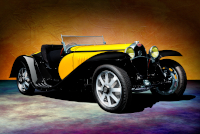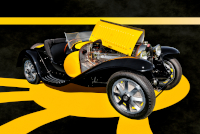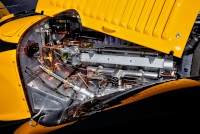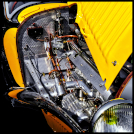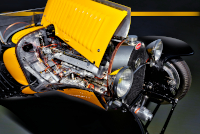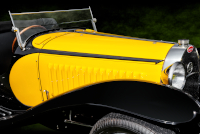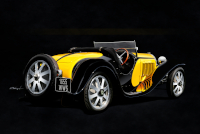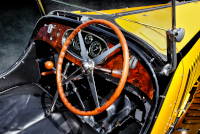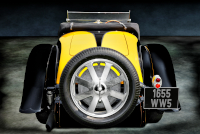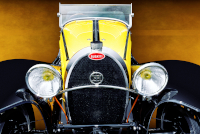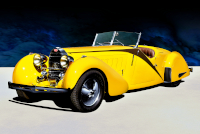Location:
Radnor Hunt Concours d'Elegance, 2017
Owner: Oscar Davis (late) | Elizabeth, New Jersey
Prologue:
For some while, I've had it in mind to compile high-contrast, black-yellow studies of the Bugatti Type 55, Lancia Belna Eclipse, and Peugeot 402 Darl'mat Coupe. One-third of the way through, I can say that the process has been tiresome. I somehow found the will, holding on to the significance of the Type 55 in terms of a Bugatti portfolio. In the process, I finished some of my favorite portrait images yet. I should stress that my workflow isn't determined at the shot, but requires decisions in terms of how to place and light the subject after the fact. The original stock excited me enough to jump into the project, and most of the decisions fell into place, even among similar compositions. The result is not the most exhaustive Type 55 gallery, but hopefully more artistic than most in its inside-out demonstration.
- - - - - - - - - -
► Image Source 1-5, 7-22: Nikon D750 (24.3 MP)
Image Source 6 by E using a Canon CMOS (20.3 MP), originally framed in square format, then repositioned, stitched, and edited by the author
References:
- Conway, H.G. "Bugatti: Le pur-sang des automobiles" Third Edition, G.T. Foulis & Co. Ltd., Sparkford, Yeovil, Somerset, England. 1974, page 250, 252-255
- RM Sotheby's: Chassis #55219 sold at Pebble Beach in 2022. RM document the history and provide a nice 63-image gallery.
- UltimateCarPage: We check our technical specifications against the megasite, with some deviation for this chassis. Work by Wouter Melissen, October 24, 2014.
- Coachbuild: The forum offers a look at the Type 55 as it appeared with Pritchard et Demollin coachwork.
The Super Sport Replaces the Grand Sport
A conglomeration of Grand Prix components, the Type 55 combines a Grand Prix chassis derived from the Type 54 with the supercharged 2.3-litre, DOHC, straight-8 motor from the Type 51. Many refer to the car as "the Jean Bugatti Roadster." Then 22 years old, Jean Bugatti steered the Type 55 toward road-going sports car specification, and also penned the coachwork.
To this extent, the Type 55 is the spiritual successor to the Type 43 Grand Sport. In his Bugatti history, H.G. Conway publishes A.C. Whincop's impressions of the Type 55 compared to the Type 43, finding both cars of similar character. The Type 55 edges its predecessor in acceleration.
Whincop writes, "Unquestionably, the most spectacular feature of the later model is its acceleration, which is really terrific; when the first car was imported into this country and was road tested by a contemporary journal in 1932, figures were recorded of 10 to 80 mph in 18 seconds and 10 to 100 mph in 40 seconds."
I realize these figures are difficult to gauge from our modern vantage. The 10 to 80 mph figure suggests a strong, quick pull on a street start through 60 mph; classic road tests rarely use a standing start, the concept being impractical at the time.
The time then required to meet the century mark suggests some taper in power delivery, but Whincop notes that the Bugatti can easily surpass 100 mph, which in itself is admirable for a small capacity sports car of the day.
Conway himself notes, "it can outperform a Type 43 in acceleration and top speed, and is very comfortable except for the tall driver who finds the leg room inadequate, but cannot adjust it. The gear change is slow and the flexible gear level cannot be manhandled as quickly as a Type 43, but on balance is better than on the earlier model. the main advantage in practice is in the engine since the combustion characteristics of the twin cam engine allow a better mixture from the carburetor and the engine is not prone to sooting as in the case of the T.43."
So, from a historical perspective, the Type 55 is a worthy successor to the Type 43, which those of the classic era and post-War period like well enough. But it is worth noting that these advocates of the classic Bugatti appreciate both cars, and in particular, recognize how good the Type 43 is to begin with.
The looking glass of time motivates classic car pundits to laud the Type 55, perhaps because of its looks, whereas the core of the artefact represents what any Bugatti sports car should be—fast, characterful, and distinctive. Jean Bugatti was good at teasing that blend out of his father's components. And here, in the Type 55, we see the potential that will come to fruition in the later Type 57 Bugatti cars.
Type 55 Chassis #55219
Chassis #55219 sells to a notary in Luxembourg through the Swiss Bugatti agent in Zurich. The notary, one Edmond Reiffers, takes delivery of a bare chassis with a temporary seat, and of course one of his sons immediately races the car before his father can send it out for coachwork.
Soon enough, Belgian coachbuilder Pritchard et Demollin complete the Type 55 as a four-seat cabriolet. Despite the touring-inspired coachwork, Reiffers' sons continue to race the car and drive it on hunting trips.
Sold on, the car survives the war hidden in Luxembourg; it emerges in 1945, and shortly suffers an accident that damages the front end. A life of hard use and some bad luck relegates chassis #55219 to a donor role by the time the car comes to California. To keep the car rolling, Ray Jones of Birmingham, Michigan later rebuilds #55219 in the 1970s with fresh coachwork.
Not until 1988, when Oscar Davis purchases the chassis, do all the pieces begin to return home. Over four years, Davis locates and acquires chassis Type 55 #55229 and Type 51 #51127 in order to reconstitute #55219 with its original components. Today, the car still wears its re-creation body from the 1970s, and it is a complete, mostly original automobile with a replacement chassis plate issued by the Bugatti Owners Club.
In sum, the Type 55 is too rare to pass up an opportunity to rebuild and save an original example. The Oscar Davis car is fortunate in that its second body beautifully represents the factory Jean Bugatti design, and that so many scattered components could be reunited.
Motor: 2,262 cc straight 8-cylinder, cast-iron block and head | 60 mm x 100 mm | 7.8:1 compression
Please note that, unless noted, the Conway quotes used in this section pertain to his reprint of The Motor from June 14, 1932.
An interesting aesthetic feature of the Bugatti straight 8-cylinder, all force-fed oil lubrication pipes are external, as Conway notes, "so that they can be readily dismantled and cleaned." A centrifugal water pump manages cooling. At the back end, the near-side camshaft drives the magneto, while the opposite camshaft drives the fuel pump.
In Bugatti fashion, the magneto sits directly behind the dashboard, immediately. Mechanical controls on the dash include an advance and retard that operates directly on the magneto contact breaker, and adjustment knobs for the shock absorbers. These controls are cleaner than many period Bugatti cars, absent of the open-back magnetos we so often see through the dashboard.
Valvetrain: dual overhead cam, chain-driven, 2 valves per cylinder
Aspiration: single Zenith 48k carburetor, Roots-type supercharger
Conway describes the supercharger's attachment as "fitted midway along the off-side of the crankcase with the carburetor underneath it and placed so low that it is reached by opening a trap door in the undershield below the level of the chassis frame members." The supercharger drives from a short, jointed shaft connected to a gear train driven from the front of the crankshaft.
The supercharger receives lubrication from a dedicated reservoir. The driver may tap the reservoir manually, whereas two outlets connect to the accelerator pedal "so that the flow of lubricant to the blower bearings starts immediately" under power.
To assist starting, the motor uses a Ki-Gass fuel injector that sprays atomized fuel directly into the intake manifold, (though the Bugatti unit is specifically an Athmos fuel injector of the Ki-Gass type).
Power: 135 bhp @ 5,000 rpm
Drivetrain: 4-speed manual gearbox, rear-wheel drive
Although of sporting character, Bugatti fit the Type 55 with a touring gearbox. In 1943, A.C. Whincop writes in Autocar magazine that first among his few criticisms is the gearbox.
"Again the touring version is very heavily built, resulting in great strength, and in this case a very quick gear change indeed, but the change is a rather heavy one with a tendency to drag when coming out of gear. To my mind, the very lightly built Grand Prix box is such a delight to handle, with its finger lightness, that it is almost sacrilege not to fit it to a Bugatti, for it allows the most effortless tunes to be played on it up or down."
The clutch remains Bugatti's patent multi-plate disc. The direct drive rear axle ratio is 3.6:1.
Front Suspension: solid axle with semi-elliptic leaf springs and tele-controlled Hartford shock absorbers
Rear Suspension: solid axle with semi-elliptic leaf springs and friction dampers
Architecture: steel ladder-frame chassis with steel coachwork
Kerb Weight: 800 kg (1,763 lbs)
Wheelbase: 2,750 mm (108.3 inches)
Top Speed: 180 km/h (112 mph)
Etymology:
Bugatti numbering follows sequential factory projects. The Type 55 debuted in 1931, placing the dual overhead cam eight-cylinder motor from the Type 51 Grand Prix into a chassis similar to the Type 45 16-cylinder Grand Prix and Type 54 Grand Prix. By all accounts a Grand Prix car in technical specification, 22-year-old Jean Bugatti penned the road-going coachwork; his influence led to the car's moniker, the "Type 55 Jean Bugatti Roadster."
Figures:
Bugatti built 38 original cars. Many reproductions followed. Mr. Oscar Davis brought chassis #55219 back to life by reunited parts that had been donated to #55229 and Type 51 #51127, purchasing all three.
Value:
Chassis #55219 appeared at RM Sotheby's Paris auction in 2023 with an asking price of €1,800,000 (approximately $1,964,986).
Good Faith: Reconstructing the Jean Bugatti Roadster
The coachwork crafted in the 1970s copies Jean Bugatti's design very closely. Coves scooped from the bonnet, flanks, and deck provide the steel canvas for high-contrast paint. Effectively a Duesenberg sweep panel design, Bugatti captured the trend in a much smaller package. Using the divides created by symmetric sweeps creates a false sense of structure, color in relief of a black skeleton. This approach is more than ornament, but intrinsic to a broader theme that lightens the entire car. How the coves play against the cut-down cockpit and bulkhead relate to the position of the driver, the view out front, and the perspective from behind. One sits right in the middle of open-closed contrast.
Grand Prix: Type 55 Attributes of the Racing Bugatti
Like many before, the Type 55 uses safety wire to lock the panels tight, with familiar single-cast eight-spoke aluminum wheels and brake drums. The Type 55 looks all of a Bugatti Grand Prix, plus running gear, windscreen, and a top.
Last Updated: Mar 26, 2025

